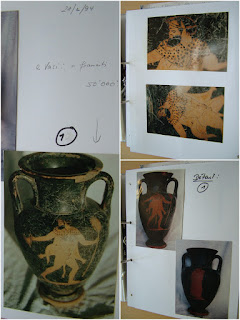Thursday, March 16, 2017 -  Auction Alert,Becchina,Becchina archive,Christos Tsirogiannis,Gianfranco Becchina,Jerome Eisenberg,looted antiquities,Maurizio Pellegrini,New York,police seizures,USA
Auction Alert,Becchina,Becchina archive,Christos Tsirogiannis,Gianfranco Becchina,Jerome Eisenberg,looted antiquities,Maurizio Pellegrini,New York,police seizures,USA
 No comments
No comments
 Auction Alert,Becchina,Becchina archive,Christos Tsirogiannis,Gianfranco Becchina,Jerome Eisenberg,looted antiquities,Maurizio Pellegrini,New York,police seizures,USA
Auction Alert,Becchina,Becchina archive,Christos Tsirogiannis,Gianfranco Becchina,Jerome Eisenberg,looted antiquities,Maurizio Pellegrini,New York,police seizures,USA
 No comments
No comments
Repatriation: Attic Red-Figure Nolan Amphora by the Harrow Painter
 |
| Image Credit: Manhattan District Attorney’s Office Left - Min. Plen. Francesco Genuardi, Consul General of Italy in New York Right - Manhattan District Attorney Cyrus R. Vance, Jr. |
On February 25, 2017 ARCA announced a second antiquities seizure at Royal-Athena Galleries, a well known New York City-based gallery operated by Jerome Eisenberg, following object identifications made by forensic archaeologist Christos Tsirogiannis. The item seized was an Attic Red-Figure Nolan amphora painted by the Harrow Painter, a vase painter known to have decorated column craters, oinochoai, and neck amphorae from approximately 480 until 460 B.C.E.
A week earlier, Tsirogiannis had informed both ARCA and the Assistant District Attorney in Manhattan, Matthew Bogdanos, that he had matched the ancient object to three images from the archive of disgraced Italian antiquities dealer Gianfranco Becchina, convicted in 2011 for his role in the illegal antiquities trade. The dealer's accumulation of business records, seized by Swiss and Italian authorities in 2002, consists of some 140 binders containing more than 13,000 documents related to antiquities, bought and sold, which at one point or another are known to have passed through Becchina's network of illicit suppliers.
Presented with irrefutable evidence of the object's illicit past, the neck amphora, valued at $250,000, was quickly forfeited by the New York dealer.
Today, in New York City, Manhattan District Attorney Cyrus R. Vance, Jr. formally handed over the amphora to the Italian authorities during a repatriation ceremony attended by Minister Plenipotentiary Francesco Genuardi, the Consul General of Italy in New York, and the Deputy Special Agent-in-Charge of Homeland Security Investigations (“HSI”) New York, Debra Parker.
According to the New York County District Attorney website, the Neck Amphora will be exhibited at the Consulate General of Italy in New York for a few months in celebration of its return before ultimately going back to Italy. Once home, the object will be placed on permanent display in one of Italy's museums which are part of the regional ‘Polo Museale del Lazio,’ a grouping of museums in the territory near Rome, some of which are in the immediate vicinity of where the object was likely looted.
The DA's website also mentioned that the amphora will be displayed in Italy with "a special mention of the decisive contribution of the Manhattan District Attorney’s Office for its repatriation."
Here is hoping there is also room on the museum's brass ID plate for the name "Tsirogiannis." It was through this diligent researcher's identification, and the earlier work of Maurizio Pelligrini from Rome's Villa Giulia, which ultimately tied this Neck Amphora to the specific group of identified traffickers, middlemen and dealers who had working relationships with Becchina. It is his analysis of the dealer's archival records, which proved to be the critical component of the evidentiary material which ultimately paved the way for the New York DA's office through the request of attorney Matthew Bogdanos, to request that this object be seized. This request for seizure in turn leading to the eventual "voluntary" forfeiture of the amphora.
As a general rule, antiquities dealers do not voluntarily give up ancient works of art worth six figures unless they have to. They do so, only when the evidence presented makes a compelling legal case which persuades them that it would probably be in their best interest to do so.
By: Lynda Albertson
















